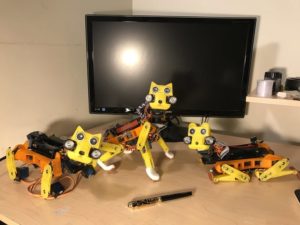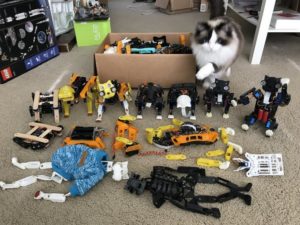 As humans, we are genetically inclined to enjoy the company of our own kind; however, this often includes welcoming cats, dogs, and other domesticated animals into our fold. Pet lovers abound around the world, and this enjoyment has even overlapped into robotics. For Rongzhong Li, an affinity for cats has transcended his work into an advanced 3D printed robotic cat.
As humans, we are genetically inclined to enjoy the company of our own kind; however, this often includes welcoming cats, dogs, and other domesticated animals into our fold. Pet lovers abound around the world, and this enjoyment has even overlapped into robotics. For Rongzhong Li, an affinity for cats has transcended his work into an advanced 3D printed robotic cat.
Li has a doctorate in physics and currently teaches at a university in Winston Salem, NC. His interests in both technology and art shine through with the OpenCat, which has some impressive moves as it walks, crawls, and navigates turns quite adeptly, and recovers itself when knocked over. It can also trot, and even lift its leg on a plant if you have one in the vicinity. OpenCat can handle rough surfaces, detect objects in its path, and is also capable of balancing itself. It also purrs, meows, and loves a good petting.
Creating this robot takes some savvy though, and Li has categorized it with a difficulty level of ‘super hard’ on hackster. If you have the chops to make such a robot though, the rewards are many. Check out the video below to see how lifelike the open-source feline is.
While you will need access to a 3D printer, there is a healthy list of hardware components required for the project, to include the recommended SparkFun Arduino Pro Mini 328 – 5V/16MHz, Raspberry Pi 3 Model B, Adafruit PCA9685 PWM and servo driver, and more. Li was inspired to make the programmable cat after checking out both the Boston Dynamic Dogs and Sony Aibo. He worked to make a maneuverable robot that is not only more affordable, but also appropriate for STEM education and needs in artificial intelligence.
“With very limited resources and knowledge, I started small,” states Li.
 He knew that in creating a smaller robot, he would be able to eliminate many of the more complex engineering issues to be found in larger electronic innovations. With the OpenCat, he was also able to create ‘faster iterations and optimization, just like rats adapt faster than elephants.’
He knew that in creating a smaller robot, he would be able to eliminate many of the more complex engineering issues to be found in larger electronic innovations. With the OpenCat, he was also able to create ‘faster iterations and optimization, just like rats adapt faster than elephants.’
Li made a motion algorithm to allow for several different robotic gaits; in fact, he saw a speed over three body lengths per second with the trotting speed. With the current motion algorithm working on a 32KB,16MHz Arduino board, Li is continuing to refine the project, with plans to move to a 256KB,48MHz board for better performance. A Raspberry Pi sits on top of the motion module, and as Li explains, it has nothing to do with manipulating more detailed mobility:
“It focuses on more serious questions, such as ‘Who am I? Where do I come from? Where am I going?’” says Li. “It generates mind and sends string commands to the Arduino slave.
“Motion instructions can still be sent to the Arduino in a slower manner. A human remote sits in the middle to intercept the robot’s control of its own body. It will still hold certain instincts, like refusing to jump down a cliff.”
Li currently has two prototypes for OpenCat:
- A standalone 8-DOF Arduino motion module, operating as a mini model. It can perform all the required skills necessary for several different gaits, and all the codes work with the full version. Li states that in that case only one parameter would need to be changed. This version is designed for makers and STEM education. Li expects the price point to be in line with that of robotic car kits today.
- A full version with the Raspberry Pi offering AI perception, using a 16-DOF motion module. Along with WiFi and Bluetooth, it is also capable of features like ground contact, touch, infrared, distance, voice, and night vision interfaces. Li has created it for consumers who are somewhat less tech savvy, and the price should be around that same as the average smartphone today.
If you are planning on 3D printing the OpenCat full version, be aware that you will need two days for printing and post processing. The parts require assembling with a collection of different accessories and tools.
“Some mechanisms are designed at <0.2mm precision and I’m currently tuning it by careful filing. Even an alternative way of soldering or wiring may cause trouble in assembling,” states Li.
“I think the most economic (and safe) way is to invest some expensive injection mold then go mass production, at least for the key mechanic parts. Once I release the files and specifications, you would probably agree with that.”
Li is still working on documentation, and you can expect to see that for the mini version of the OpenCat much earlier. The designer asks that you watch the OpenCat video (above), like it, and share.
“Your support will determine how soon it will be available on the market,” says Li.
What do you think of this news? Let us know your thoughts; join the discussion of this and other 3D printing topics at 3DPrintBoard.com.
[Source/Images: hackster.io]
Subscribe to Our Email Newsletter
Stay up-to-date on all the latest news from the 3D printing industry and receive information and offers from third party vendors.
Print Services
Upload your 3D Models and get them printed quickly and efficiently.
You May Also Like
3D Printing News Briefs, June 11, 2025: Sustainability, Automotive Tooling, & More
We’re starting with sustainability news in today’s 3D Printing News Briefs, as EOS has strengthened its commitment on climate responsibility, and Zestep is making 3D printing filament out of eyewear...
3D Printing 50 Polymer Stand-In Parts for Tokamaks at the PPPL & Elytt Energy
Of all the world’s things, a tokamak is one of the hardest, most complex, expensive and exacting ones to make. These fusion energy devices make plasma, and use magnets to...
3D Printing News Briefs, May 17, 2025: Color-Changing Materials, Humanoid Robot, & More
We’re covering research innovations in today’s 3D Printing News Briefs! First, Penn Engineering developed 3D printed materials that change color under stress, and UC Berkeley researchers created an open source,...
Firehawk Aerospace Partners with JuggerBot 3D, Gets $1.25M from AFWERX for 3D Printed Propellants
Texas-based Firehawk Aerospace, an advanced energetic materials firm that works with aerospace and defense applications, announced a strategic partnership with JuggerBot 3D, an Ohio-based large-format 3D printer manufacturer. Together, the...





































